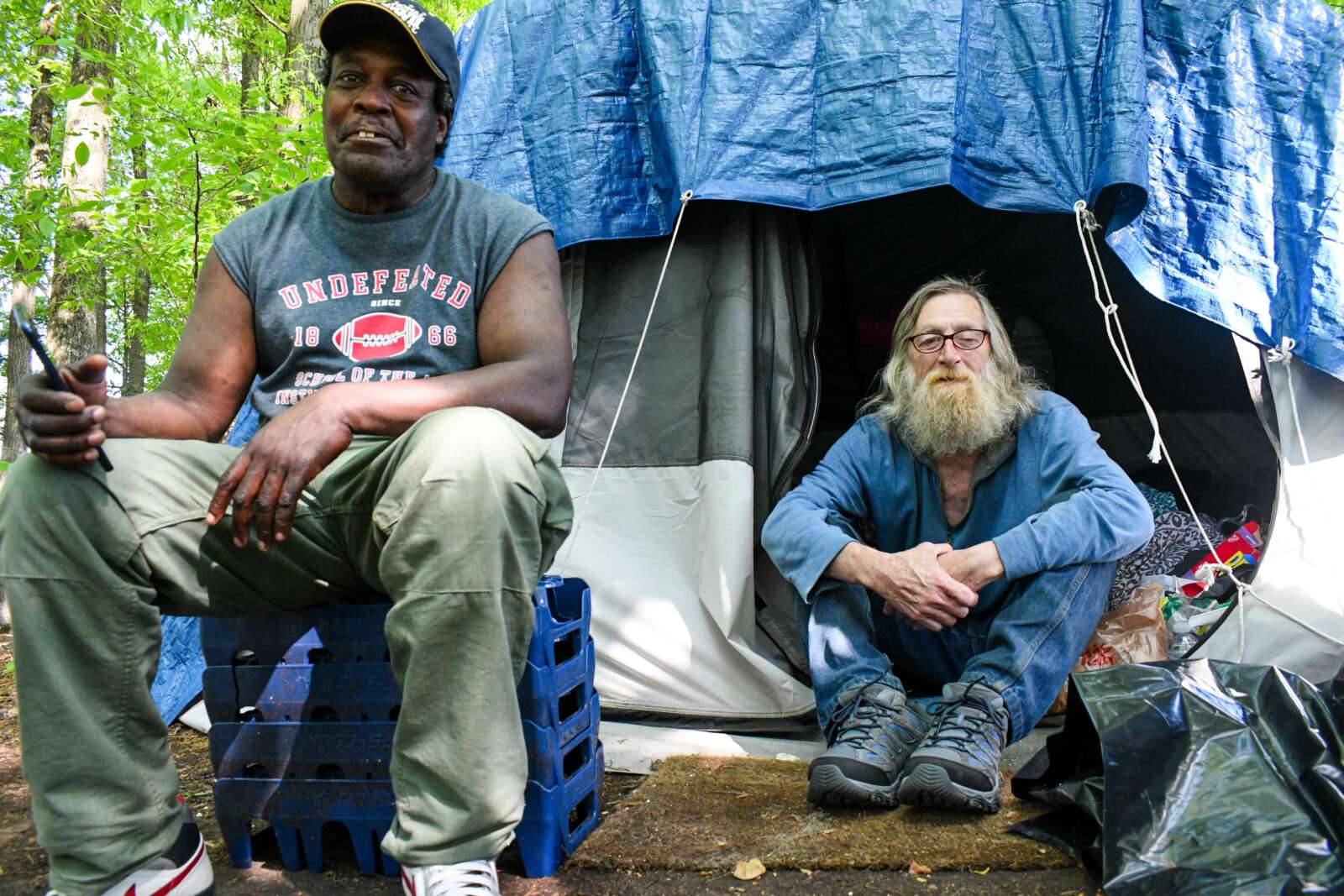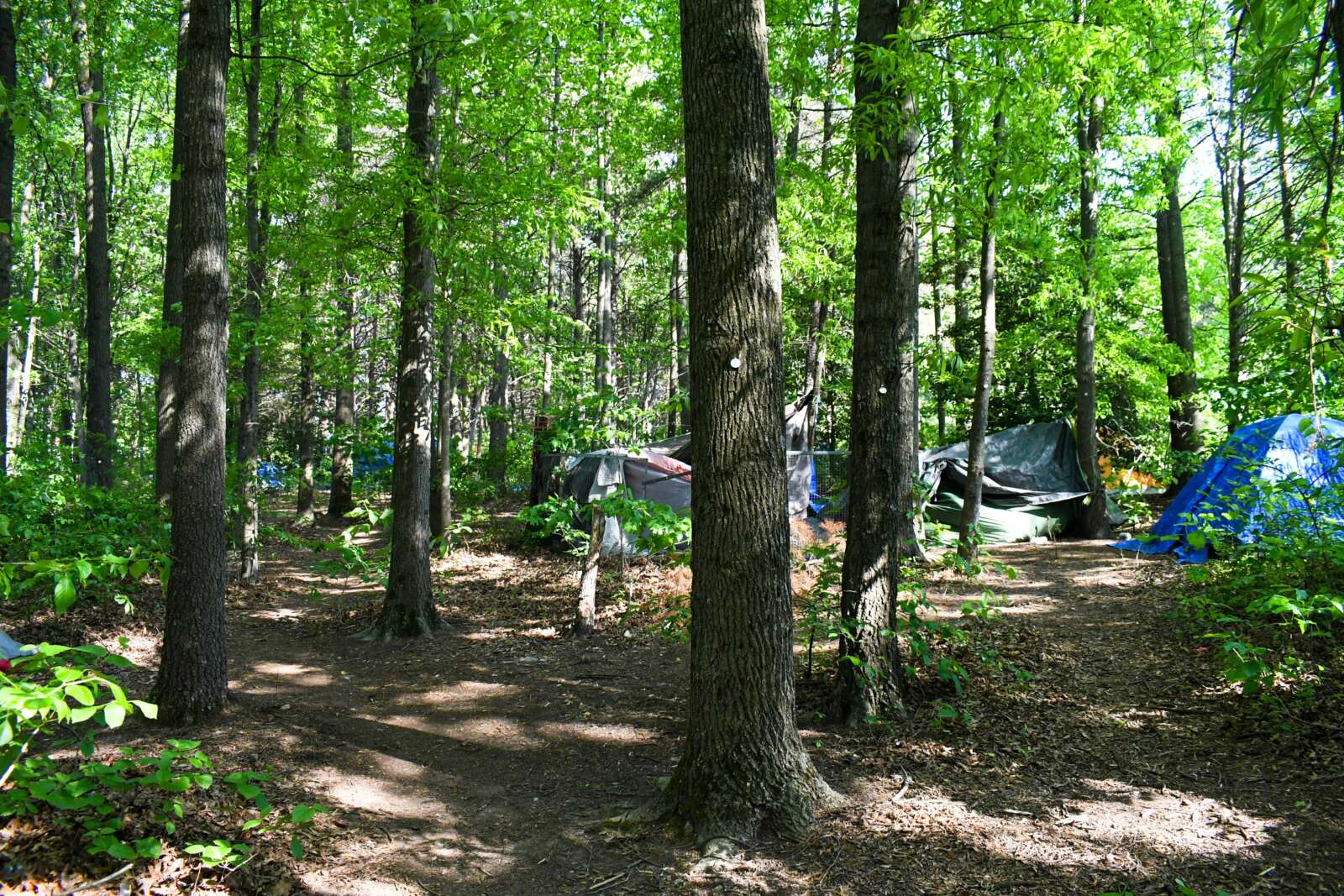(Updated at 2 p.m. on 05/10/2024) As the Virginia summer looms, residents of Reston’s tent encampment are preparing for challenges beyond sweltering temperatures.
Many are anxious about the impending installation of no-trespassing signs, which will mark the beginning of a two-week countdown before they must leave the forested area between Inova’s emergency room, the North County Government Center and Sunrise Assisted Living. The encampment stretches across multiple properties owned by Inova and the county.
Fairfax County officials have assured the 40-plus unhoused individuals residing at the encampment — the largest in the county — that they will get access to a temporary shelter at the North County Human Services Center across the street, once the no-trespassing signs go up.
However, encampment residents, like Andy “Pops” Whiddon and Xavier Turner, say they’re reluctant to move because of health risks, such as diseases and parasites, that come with crowded shelters.
“I’m not gonna sleep six inches from somebody else,” Whiddon told FFXnow. “It’s a health hazard.”
Temporary shelter plans in limbo
Whiddon, who has been at the encampment for about eight months, says he and his neighbors were left in the dark for weeks about when the site will be cleared.
Their concerns were somewhat eased when Hunter Mill District Supervisor Walter Alcorn said during a town hall-style meeting at the government center in April that it may be another few months before the no-trespassing signs are put up.
“He said, ‘You won’t know until they put up the no trespassing signs,'” Whiddon recalled. “Once they put up the signs, then we have two weeks we gotta go. And we got no choice.”
Alcorn told FFXnow by email on Friday (May 3) that the county is still in the process of creating a temporary shelter, and he was told by the Office to End and Prevent Homelessness it would be a “matter of weeks rather than months” until it was ready.
“I had shared this information with residents in and around Reston Town Center North — including unhoused individuals,” Alcorn said. “I have asked county staff to keep me updated on progress towards getting this critical service in place, and as soon as plans for this temporary overflow shelter are available, I will make sure they are shared with all interested parties in our community.”

Thomas Barnett, deputy director of the Fairfax County Office to End and Prevent Homelessness, said he would announce more details about the temporary shelter “shortly” but declined to provide an official timeline or specific details about the project.
“Fairfax County aims to compassionately wind down the encampment of people experiencing homelessness in Reston and connect these individuals to housing and other services,” Barnett said. “We continue to formalize plans to enable the temporary overflow shelter and our plan is to begin transitioning people once it is open.”
Concerns over shelter conditions
But even when the shelter is ready, Whiddon and Turner say they’re wary about moving in, primarily due to health concerns.
Whiddon argues that homeless shelters, including the ones provided by county, are problematic because the close quarters increase the risk of contracting diseases, such as COVID-19.
Turner pointed to tiny red dots on his arms that he said came from lice and bed bugs he picked up two months ago while at the hypothermia prevention program site in the North County Human Services Center (1850 Cameron Glen Drive), an experience that makes him reluctant to return.
“I understand where Pops is coming from,” Turner told FFXnow. “…I don’t want to be around nobody six feet from me, coughing, bugs, all that. It’s crazy, man.”
Before becoming unhoused, Whiddon worked at a 7-11 in Richmond. However, he quit due to health concerns at the start of the pandemic and moved to the Reston area to be closer to his sister, who lives in Herndon.
“It was unsafe,” Whiddon said. “I worked there for five years. They wanted me to become the general manager…I left because I had people coming in there everyday coughing and sneezing at me, and I’m going ‘Ah, this is not good,’ so I left.”
Although Whiddon has severe health issues, he prefers living outdoors and keeping his distance from people. If forced to leave the encampment, he’s unsure where he would go but is adamant about not sleeping in a shelter.
Turner, who worked at a Harris Teeter in Ashburn before becoming unhoused, says he would return to work and pay for housing if he had the option. However, he says it’s been difficult to secure employment while unhoused.
“I just want a bed, and go to work and go home and have peace of mind,” Turner said.
A fight for survival in the shadows
Sarah Selvaraj-D’Souza, executive director of the local community activist group Reston Strong, told FFXnow that the primary obstacle preventing people at the encampment from leaving is their inability to secure housing.
She says it’s a vicious cycle, as the daily struggle for survival hinders their ability to pursue other essential activities, such as finding work and securing housing.
“When they wake up in the tent, the first question is, ‘Am I walking to Harris Teeter to use the bathroom? Am I going down to the shelter to take a shower? Where is my breakfast coming from? Is it going to rain today? What happens to my belongings when they’re in a tent?'” Selvaraj-D’Souza said. “…They’re trying hard…But housing is the solution.”
With the county’s temporary shelter not yet established, Selvaraj-D’Souza says Reston Strong is concerned about whether it will operate 24 hours a day or only open at night.
“In the event that the temporary overflow shelter ends up being just a nightly program, Reston Strong is exploring daytime solutions,” she said.
According to county records, the organization has asked Zoning Administrator Leslie Johnson if it would be feasible to operate a “non-residential drop-in facility for adults of all ages, backgrounds, and capabilities” at a property near the Wiehle-Reston Metro station.
Selvaraj-D’Souza clarified that they’re exploring a few locations in the area as a precaution. If the county announces that its new temporary shelter will operate 24 hours a day, she says Reston Strong doesn’t plan to proceed with creating a daytime-only shelter.
“With the library being closed in the middle of summer, there’s definitely a need for…a cooling center space during the day that folks can go and shelter from the elements,” she said. “And everyone talks about hypothermia in the winter, but given climate change and the kind of temperatures we’ve been seeing during the summer, it’s no secret that Fairfax County has been…talking about how do folks get some kind of break from the elements during the day in summer.”
The county utilizes public facilities, like libraries, as cooling centers during days with extreme heat. In addition to providing shelter, the sites are stocked with bottled water, sunscreen and other supplies when activated.
Regardless of what the county does, Whiddon says he’s less concerned about exposure to heat than about where he will go after the encampment is shut down.
“To tell you the truth, I don’t mind living in a tent because everybody here leaves me alone because I’m an old guy,” Whiddon said. “I don’t know what I’m gonna do.”
Map via Google Maps. This story previously stated that the encampment property is owned by Inova.



